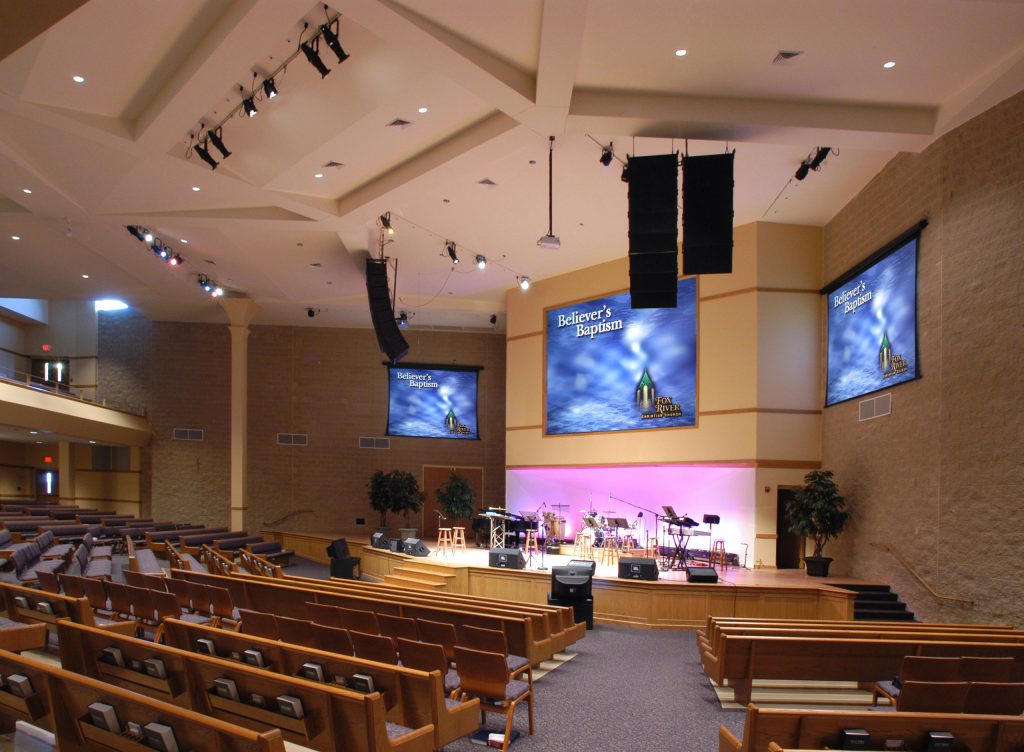Line Arrays
How they work and how they can provide outstanding sound

Is a line array right for your facility?
It may be if you need a loudspeaker system that can be aimed accurately to place sound just where you want it and can provide an even distribution of volume levels from the front to the back of your room.
Because low-frequency sounds are not directional and will spread out everywhere in the room, it’s impossible to keep some sound pressure off a stage with standard loudspeakers. Thus feedback is always a concern and microphone gain must be carefully monitored and controlled.
But with a line array, even low tones are directional and it’s possible to keep nearly all sound away from the area under the array. With a line array, you can turn up the mics enough for loud, clear pickup from non-professional voices, even from people who are nervous and speaking very low.
The physics of line arrays
A line array is a column of speakers with these two special characteristics:
- The drivers must be stacked, centre-to-centre, closer than half the wavelength of the frequencies they produce.
- The entire stack taken together must be twice the wavelength of the frequencies to be controlled.
When both are true, the individual speakers no longer act as point sources of sound. The inverse square law no longer applies, so the sound level falls off much more slowly with distance. Most importantly, the sound dispersion pattern shifts from a sphere to a cylindrical shape that can be accurately aimed by the design and placement of the array.
These requirements in turn force two important limitations:
- Because the lowest frequency the array will control has a wavelength half the array’s height, there’s a minimum size requirement for an effective array.
- Because the wavelengths of high frequency sounds are very short, and because there’s a minimum height that a speaker cabinet can be built, there’s a maximum frequency that an array can control.
Nonetheless, advances in the last ten years have made arrays more and more practical.
Some manufacturers are building drivers with a center-to-center distance of about 3/4 of an inch, greatly extending the frequency range they will control. All are coupling arrays with digital signal processors, enabling us to fine-tune the array’s dispersion pattern and produce very consistent sound. The result is a line array designed for smaller venues capable of producing a very high-quality sound that’s consistent throughout the seating areas.
Design Considerations
Given the physics involved and the limits of modern manufacturing, arrays are appropriate only in relatively wide venues with high ceilings.
At a minimum, you need a ceiling higher than about 12’, so there is space to put a 6’ or taller array above a stage and still have sound-deadening benefits below. Generally speaking, you want an array that’s 9’ or taller and a ceiling closer to 30’.
In narrow rooms, it can be difficult or impossible to keep the sound from reverberating off sidewalls.
Most often it’s better to go with an alternative speaker system design when either of these conditions is true.
One more caution: an array can sound terrible if it’s not designed and placed properly for your venue. This is a highly technical product that requires a great deal of experience and expertise from the installer.
That being said, in an appropriate room, a line array properly designed and installed can produce truly spectacular sound. The softest voices are loud and clear. Music is crisp and present. If you’re sitting 70’ back, violins sound like they’re 20’ away. It can sound so much better than what you expect, it’s startling.